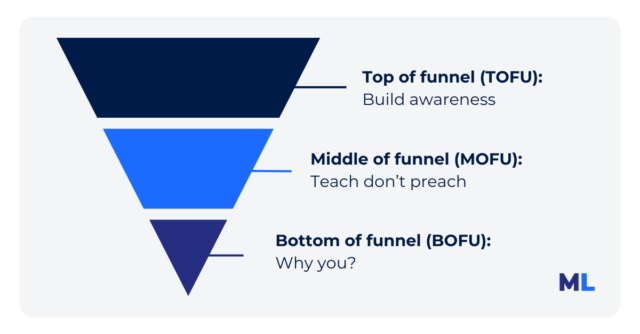
Unlock Global ABM at Scale — Madison Logic strengthens ABM reach with Connected TV and Audio expansion globally. Learn More
Unlock Global ABM at Scale — Madison Logic strengthens ABM reach with Connected TV and Audio expansion globally. Learn More

According to research from LinkedIn, at any given time, only 5% of the B2B accounts you’re targeting are in-market for your solution. The other 95% are either not yet in-market or are simply not ready to buy.
As a result, your marketing campaigns may say the right things, but don’t achieve what you want because many of these target accounts are just not ready to engage with your sales team.
More often, the readiness of a B2B buying group is dictated by certain factors like:
So, how do you as a marketer focus on the 5%, while still moving the needle for those 95% not in-market and not ready to buy? In this article, we’ll give you the basics on how to execute successful lead and account nurturing programs.
A marketing nurture program is a strategy to stay top-of-mind with potential buyers and drive them through the buyer’s journey. This strategy results in higher awareness and education for an individual or “lead” across the entire buying committee within an account. In some cases, successful nurturing can make or break deals and make unsung heroes out of today’s marketing teams.
There’s lead nurturing and account nurturing, but what’s the difference?
A critical component of effective nurturing is understanding that B2B buyers in accounts comprise of more than one decision-maker-maker. 2024 Forrester Research found that on average there are 13 people involved in a purchase decision with 89% of purchases involving two or more departments. Each member of the buying committee has pain points when considering investing in a solution to solve a problem. Since these pain points may not be the same, each member must defend and/or showcase multiple pieces of content they uncover in their buyer research to the rest of the committee to reach a purchase decision. If you execute successful lead and account nurturing, this buying committee will present content about or relating to your solution as the answer to their departmental and individual problems and align on a decision.
A successful nurture program exercises both account and lead nurturing because the end goal is the same: drive the prospective account into a sales opportunity.
Effective lead nurturing is not a one-and-done job. The most successful campaigns influence accounts at every stage of the buyer’s journey based on lead scoring key buying stage metrics. When we think about the buyer’s journey in terms of the sales funnel, there are three common phases for top, middle, and bottom of the funnel activity:

Your job as a marketer is to guide potential buyers throughout the buyer’s journey with relevant content and messaging that:
Nurturing each member of the buying committee with relevant content and messaging for their buying stage drives higher account engagement and stronger consensus across multiple stakeholders—ultimately leading to faster conversion as they reach a unanimous decision together.
Here are the key components to building out a successful nurture strategy in ABM.
To successfully nurture leads, you must first understand your customer. Engagement and intent data provide the foundation for crafting detailed buyer personas and accurately mapping the customer journey via customer relationship management (CRM) and marketing automation. By analyzing behaviors, interactions, and intent signals, you can identify what content appeals to different buyer personas at specific stages of the buying cycle.
For example, tracking interactions such as email opens, web visits, and content downloads helps marketers understand the specific pain points and challenges a prospect is facing. This insight allows you to tailor content and messaging to meet the prospect where they are in their journey, increasing the likelihood of engaging them effectively.
Being where your audience is, and where they will be, is key to an effective nurture strategy. ABM thrives on personalized, multi-channel engagement that delivers the right message, at the right time, and through the right channel. This means using a blend of channels such as email campaigns, social media, retargeting ads, content syndication, and connected TV ads—ensuring your messaging is consistent and omnipresent across all touchpoints.
The cornerstone of any ABM nurture campaign is personalization. With the deep insights gained from engagement and intent data, you can craft content that speaks directly to a buyer’s unique pain points, needs, and interests. Each piece of content should serve a purpose in moving the prospect forward in their journey. Whether it’s a blog post, a whitepaper, case study, or webinar invite, personalization should be prioritized in every stage of the nurture flow. Multiple touches across different formats and channels help reinforce your message and build trust, keeping your brand top of mind for prospects.
Sales and marketing alignment is vital in ABM nurture campaigns so it’s important to take notes of the sales process and how accounts interact with your teams. Lead scoring enables both teams to prioritize high-value prospects, ensuring that marketing focuses on nurturing accounts with the highest potential to convert, while sales can prioritize leads that are sales-ready. Lead scoring should take into account key buying stage metrics, such as engagement with content, readiness to purchase, and intent signals.
Collaborating with sales to define the criteria for high-value leads, such as engagement with specific content or meeting certain behavioral thresholds, helps improve the overall efficiency of the nurturing process. Together, marketing and sales can ensure they are both working toward the same goals, ensuring a seamless handoff from nurture to close.
Finally, a successful ABM nurture strategy is iterative and data-driven. Continuously measuring the effectiveness of your campaigns through ABM software and regular performance tracking helps you stay ahead of the curve. Key metrics such as email open rates, content engagement, and account-level interactions provide insights into what’s working and what isn’t.
As you gather this data, optimizing your strategy is critical. If certain content types are resonating better with your target accounts, double down on those. If you notice certain accounts are falling out of the funnel early, reassess how they’re being nurtured and adjust the messaging accordingly. By continually optimizing based on insights, your campaigns will become more effective over time, leading to higher conversion rates and more opportunities for your sales team.
After hosting a webinar on AI-powered helpdesk software, you capture attendees from a key account buying committee. Not everyone is ready to engage with sales, but that’s where targeted nurturing steps in. Each persona on the committee has different needs and engagement triggers, allowing you to guide them through the buying journey with personalized content.
Why would they say no? This could be a couple of reasons:
You already know that the account and these personas have shown interest in your solution and company, and you can score them accordingly, but to get them to the next step, you have to continue the conversation with relevant content. Let’s look at each potential path for three main buyer personas.
The IT Manager watches the webinar and downloads a technical guide on system integrations. To nurture them, you send content via email marketing focusing on how your software fits into existing IT infrastructures—like case studies and whitepapers with engaging CTAs. This helps the IT Manager move closer to considering your solution in their technical environment.
The Customer Support Lead engages with content on improving team collaboration and response times. You nurture them with video demos, blog posts through LinkedIn posts, and whitepapers via display advertising showcasing how your software enhances support workflows. This helps them see the solution’s direct benefits to their team, advancing them to the next stage in the buying process.
The CFO, initially less engaged, later downloads an ROI calculator and a case study on cost savings. You send them ROI-focused content, including pricing guides and success stories highlighting financial benefits. This helps the CFO justify the investment and move toward a purchasing decision.
By nurturing each persona with relevant content, you address their unique concerns—technical, operational, and financial. As they move through their journey, each persona builds a stronger case for the solution, increasing the likelihood of consensus within the buying committee and driving them closer to making a purchase decision.
When you create a nurture path based on buyer characteristics and engagement, each asset offers an opportunity to build trust with every touchpoint and keep your solution top-of-mind as potential customers go through the buyer’s journey at their own pace. Regardless of what content you share, the focus must be to help them understand the solutions that help them solve their problem.
When we think about the benefits of nurturing, it’s essential to keep a few things in mind:
Think about your most important deals. They should all have three things in common: they were ready to buy with your sales team, understood the value of your solution, and they trust and have a relationship with your brand. Nurturing is about checking off these boxes before they speak to the sales team.
Effective nurturing requires more than just sending emails—it’s about delivering the right message at the right time based on real buying signals. Madison Logic removes the guesswork by using engagement and intent data to guide your marketing and sales teams toward the next best action in your account and lead nurturing efforts.
Want to refine your nurturing strategy? Download our eBook, 8 Bad Nurturing Habits in ABM and How to Break Them, to learn what’s holding you back.
Ready to see how ML can power your 2025 ABM campaigns? Request a demo today.